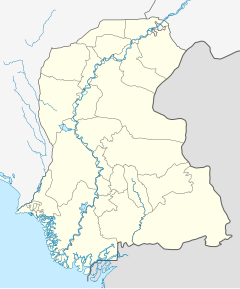Draft:Jamnindo Marri
| This is a draft article. It is a work in progress open to editing by anyone. Please ensure core content policies are met before publishing it as a live Wikipedia article. Find sources: Google (books · news · scholar · free images · WP refs) · FENS · JSTOR · TWL Last edited by Saqib (talk | contribs) 16 days ago. (Update)
Finished drafting? or |
This article relies largely or entirely on a single source. (October 2024) |
Jamnindo Marri is a village situated in the Sanghar District of Sindh, Pakistan, approximately 250 km east of the provincial capital Karachi. The village falls in Deh Rachhar of Sanghar Tehsil within Sanghar District[1].
History
[edit]Jamnindo Marri was established at a time when there was no formal canal irrigation system in the area.[citation needed] The water supply relied on two watercourses called "Laila" and "Majnun," which branched off from the "Dim Wah" canal that passed through Sanjhoro Taluka to the west of the village. These watercourses flowed from the northern and southern parts of the village, but their water supply was often insufficient by the time they reached the village.[citation needed]
Due to the frequent scarcity of water, there was a significant need for a reliable water source. To address this need, Chief Jamnindo Khan made the decision to dig a well in the village.[citation needed] A large well, with a diameter of 10 feet, was excavated and later lined with bricks. This well, approximately 100 feet deep, became a vital source of water for the residents and livestock of the village. A traditional water-lifting device known as a "Naar," operated by a camel, was installed over the well, allowing villagers to draw water for drinking and other uses.[citation needed]
The well in Jamnindo Marri is considered an important part of the historical heritage of Sanghar District.[citation needed] It has been documented in a survey conducted by the Department of Ancient Historical Sites, with the intention that it may be recognised as a protected historical site in the future.[citation needed]
Founder
[edit]Jamnindo Marri was founded by Chief Jamnindo Marri, who belonged to the Kungrani clan of the Marri tribe.[2] The Kungrani Marri are a sub-group of the Bijarani branch of the Marri tribe. The original homeland of the Marri Baloch is the Kohlu District of Balochistan, particularly in the Mawand Tehsil, which includes a mountain range known as "Koh-e-Safed."
Demographics
[edit]Jamnindo Marri has primarily Muslim residents, along with a notable Hindu population.
The economy of Jamnindo Marri is mostly tied to agriculture, with a smaller contribution from government jobs.
The village is home to various castes and communities, some of which are long-term residents, while others migrated temporarily for labor. The permanent residents of Jamnindo Marri include:
- Marri Baloch
- Khaskheli
- Daheri
- Muhana (initially known as "Mallah," later as "Mirbahar")
- Mochi (later known as "Bhatti")
- Kumbhar (later known as "Panhwar")
- Syed
- Shar
- Sheikh
- Wania
- Oad
- Bheel
- Menghwar
Temporary migrants who moved to the village for work included:
- Shahani - Permanent residents of the Kaachho area of Gaji Shah, Taluka Johi, District Dadu.
- Kachhi Kolhi
- Bheel (from Thar)
These laborers migrated from various parts of Thar and Kaachho for work. When they observed lightning and rain in their home regions during the monsoon season, they would gather their earnings, such as wheat and other grains, and return to their homes.
Cultural and Historical Importance
[edit]Jamnindo Marri holds cultural and historical significance for its association with the Marri Baloch people and its heritage structures. The well dug by Chief Jamnindo Khan is a symbol of the resilience of the local community in overcoming challenges posed by a lack of water resources. Efforts are being made to formally recognize this well as a protected historical site, underscoring its importance to the history of Sanghar District and the Marri tribe.
References
[edit]- ^ "Sānghar | Sindh Province, Indus River, Thar Desert | Britannica". www.britannica.com. 5 September 2024. Retrieved 20 October 2024.
- ^ . Encyclopædia Britannica. Vol. 17 (11th ed.). 1911. p. 753.

